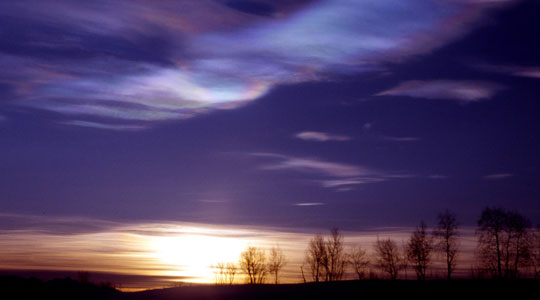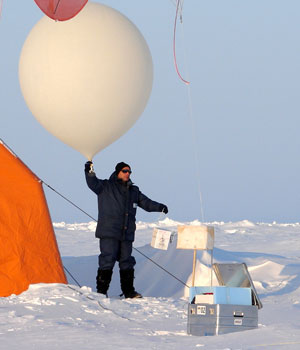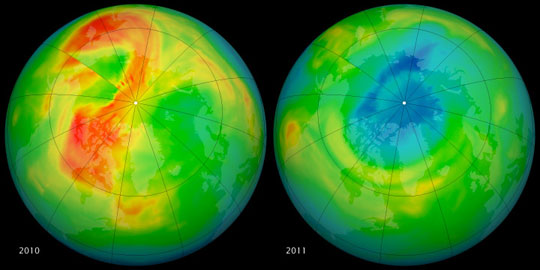High over the Earth’s surface, suspended in our stratosphere, an invisible blanket of ozone quietly protects all life on Earth from dangerous ultraviolet (UV) rays. The gas, made up of three oxygen atoms, has an incredible ability to absorb UV radiation in the particular range that is most harmful to plants and animals. In 1985, scientists noticed something wrong with that blanket. In the Southern Hemisphere spring, the ozone layer over Antarctica was disappearing. This phenomenon, now known as the ozone hole, has reappeared over Antarctica every spring since then, varying in intensity from year to year.
The ozone hole over Antarctica is worrisome, but on that frozen continent there are few animals and fewer people for harmful UV rays to damage. However, when ozone-depleted air moves from Antarctica northwards to more populated regions like Australia and New Zealand, it can become a serious health concern. In middle latitudes and the Northern Hemisphere, ozone has declined much more slowly. If something like the Antarctic ozone hole happened over the more-populated Arctic, it would expose far more people to high UV radiation. So in 2011, Gloria Manney, a researcher at NASA's Jet Propulsion Laboratory, was concerned when she and her colleagues spotted a major decline in Arctic ozone. She said, “In the Northern Hemisphere, before this past winter, we had seen only moderate amounts of chemical ozone loss. We hadn’t seen anything comparable to the Antarctic ozone hole.” What was causing the new ozone hole? And would it happen again?
The ozone hole over Antarctica
When Manney and other researchers announced their finding, many people were surprised. Pieternel Levelt, principal investigator for the Ozone Monitoring Instrument (OMI) on NASA's Aura satellite, said, “A lot of people thought that the problem was already solved.” Indeed, governments signed an international treaty in 1989 that banned production of chlorofluorocarbons (CFCs) and other ozone-destroying chemicals. And data show that chlorine in the stratosphere has started to decline. But the chemicals are so long lived that it will be many decades before the Antarctic ozone hole stops forming each winter. “We still have an ozone hole at the South Pole, but we expect that it will recover by 2050 to 2070,” said Levelt.
Starting in the 1970s, scientists had suspected that the ozone layer might be at risk. Chlorine-based compounds known as CFCs, very stable and long-lived on Earth’s surface, were slowly making their way into the upper atmosphere, where the additional UV light broke them apart into highly reactive chlorine molecules that tear ozone molecules apart. But researchers did not expect anything as extreme as an ozone hole; ozone destruction normally proceeds slowly in the stratosphere. At the same time, new ozone is always forming through reactions between sunlight and oxygen compounds.
Scientists first spotted the ozone hole in 1985, using ground-based sensors to study the Antarctic atmosphere. Earlier data from the Total Ozone Monitoring Satellite (TOMS), a satellite launched in 1979, had shown the same low ozone levels, but because levels were so extremely low, researchers had assumed that the data were incorrect. When they looked at the data again, they confirmed that the hole was real.
Researchers soon figured out the cause of the ozone hole. Long-lasting extreme cold in the Antarctic stratosphere in winter created the perfect conditions for chemical reactions that destroy ozone at a much faster pace than those that take place elsewhere in the atmosphere. When temperatures are very low in the stratosphere, nitric acid and water can turn from gas into liquid or solid forms, resulting in a wispy multicolored cloud called a polar stratospheric cloud. These frozen particles of acid and water provide surfaces on which the chemical reactions that convert chlorine into ozone-destroying forms can take place. Michelle Santee, another JPL researcher studying the Arctic ozone loss, said, “If you just had gaseous molecules, as is the case in most of the atmosphere, these reactions would not occur.”
Measuring Arctic ozone loss
Outside of Antarctica, stratospheric temperatures rarely get low enough for polar stratospheric clouds to form, nor do they typically stay low long enough for chlorine to persist in ozone-destroying forms. So when Santee and Manney saw a large decrease in ozone over the Arctic during routine inspection of data from NASA's Microwave Limb Sounder (MLS), they wondered how bad the problem was. MLS data archived at NASA's Goddard Earth Sciences Data and Information Services Center (GES DISC) showed that about 80 percent of the ozone at 18 to 20 kilometers altitude had been destroyed—far more ozone loss than ever previously seen over the Arctic. Confirming the MLS data, balloon-borne ozonesondes released every year over the Arctic provide a high-resolution series of data dating back to the 1990s, before the MLS record began; balloons have also provided measurements of ozone over the Antarctic since the 1980s. Manney said, “These comparisons were important in establishing that the ozone loss in 2011 was unprecedented in the Arctic, and that it was comparable to that in some Antarctic ozone holes.”
But while MLS and the balloon-borne ozonesondes measure ozone at different altitudes, they do not provide a measurement of the total ozone column. Manney said, “If you’re standing on the surface of the Earth, worried about getting a sunburn, what you really want to know is the total amount of ozone overhead.” For that information they turned to Levelt and her colleagues who work with OMI, which measures the vertical column of ozone. Levelt said, “The definition of whether an ozone hole is present or not has historically been based on total column measurements.”
The OMI data, also archived at GES DISC, showed extremely low total ozone values over a much larger region than had ever been seen in the Arctic since satellite measurements started in 1979. However, the ozone loss was not as severe as that in the annual Antarctic ozone hole, which has grown in size and intensity over the last twenty years. Manney said, “The amount of ozone that was destroyed was comparable to what we saw a couple of decades ago in the Southern Hemisphere, when we first started studying the Antarctic ozone hole.”
Manney and Santee also needed to know whether the ozone loss was caused by chlorine-containing chemicals, and whether polar stratospheric clouds were present in the Arctic atmosphere. Temperatures in the Arctic stratosphere had been unusually low, which meant that the polar stratospheric clouds that catalyze ozone destruction were likely to form. Data from the Cloud Aerosol Lidar with Orthogonal Polarization (CALIOP) sensor on the NASA/French Space Agency Cloud-Aerosol Lidar and Infrared Pathfinder Satellite Observation (CALIPSO) satellite, archived at NASA's Atmospheric Science Data Center (ASDC), confirmed the team’s suspicions, showing that polar stratospheric clouds were indeed present during the time ozone values were decreasing.
Together, the data gave a comprehensive picture of the conditions that led to the unprecedented Arctic ozone depletion. “The data from all of these instruments played vital roles; they all provided pieces of the puzzle,” Santee said.
An altered Arctic atmosphere
The Arctic ozone hole was both expected and unexpected. “We knew that this could happen,” said Manney. “What was a surprise was that it happened this particular year. Because the temperatures are so variable in the Arctic, we can’t predict from year to year whether a given winter is going to be particularly cold.”
That means that the obvious question—will the Arctic have another ozone hole next year, or the year after—is difficult to answer. Some evidence suggests that climate change may be making the stratosphere more conducive to ozone loss. Manney said, “Because of radiative effects, if you make the lower atmosphere warmer, you’d expect the stratosphere to get cooler.” If stratospheric temperatures get lower, the conditions that lead to ozone loss may become more common.
The researchers emphasize that people should not be alarmed about a persistent Arctic ozone hole. The protocols that banned ozone-destroying chemicals have been very effective, chlorine levels are beginning to decline, and even the annual Antarctic ozone hole is expected to end by around 2050. But as we wait for chlorine to slowly filter out of the stratosphere, ozone holes in the Arctic could become more common—potentially damaging plant life and making sunburns and skin cancer more of a problem for people who live in the Arctic. “Because of climate change, the stratosphere is not exactly the same place it was in the 1970s,” Santee said. “If because of climate change the stratosphere gets colder in the future, we could be looking at more severe and more persistent ozone holes in the Arctic.”
Reference
Manney, Gloria L., et al. 2011. Unprecedented Arctic ozone loss in 2011. Nature 478, doi:10.1038/nature10566.
For more information
NASA Goddard Earth Sciences Data and Information Services Center (GES DISC)
NASA Atmospheric Science Data Center (ASDC)
Microwave Limb Sounder (MLS)
Ozone Monitoring Instrument (OMI)
Pieternel Levelt
| About the remote sensing data used | |||
| Satellite | Aura | Aura | Cloud-Aerosol Lidar and Infrared Pathfinder Satellite Observation (CALIPSO) |
| Sensor | Ozone Monitoring Instrument (OMI) | Microwave Limb Sounder (MLS) | Cloud-Aerosol Lidar with Orthogonal Polarization (CALIOP) |
| Data sets | Aura OMI Total Ozone Data Product | Trace Gas Profiles, Ozone Profile | Polar Stratospheric Cloud, Aerosols |
| Resolution | 13 by 24 kilometers | 4 kilometers | 5 kilometers |
| Parameter | Ozone | Trace gas profiles and ozone profile | Clouds, aerosols |
| DAACs | NASA Goddard Earth Sciences Data andInformation Services Center (GES DISC) | NASA GES DISC | NASA Atmospheric Science Data Center (ASDC) |
| CALIPSO is a joint satellite mission between NASA and the French Agency, Centre national d'études spatiales (CNES). | |||
The photograph in the title graphic shows polar stratospheric clouds over Norway. (Courtesy Remi Longva, http://www.flickr.com/photos/remilongva/2206130121/)


